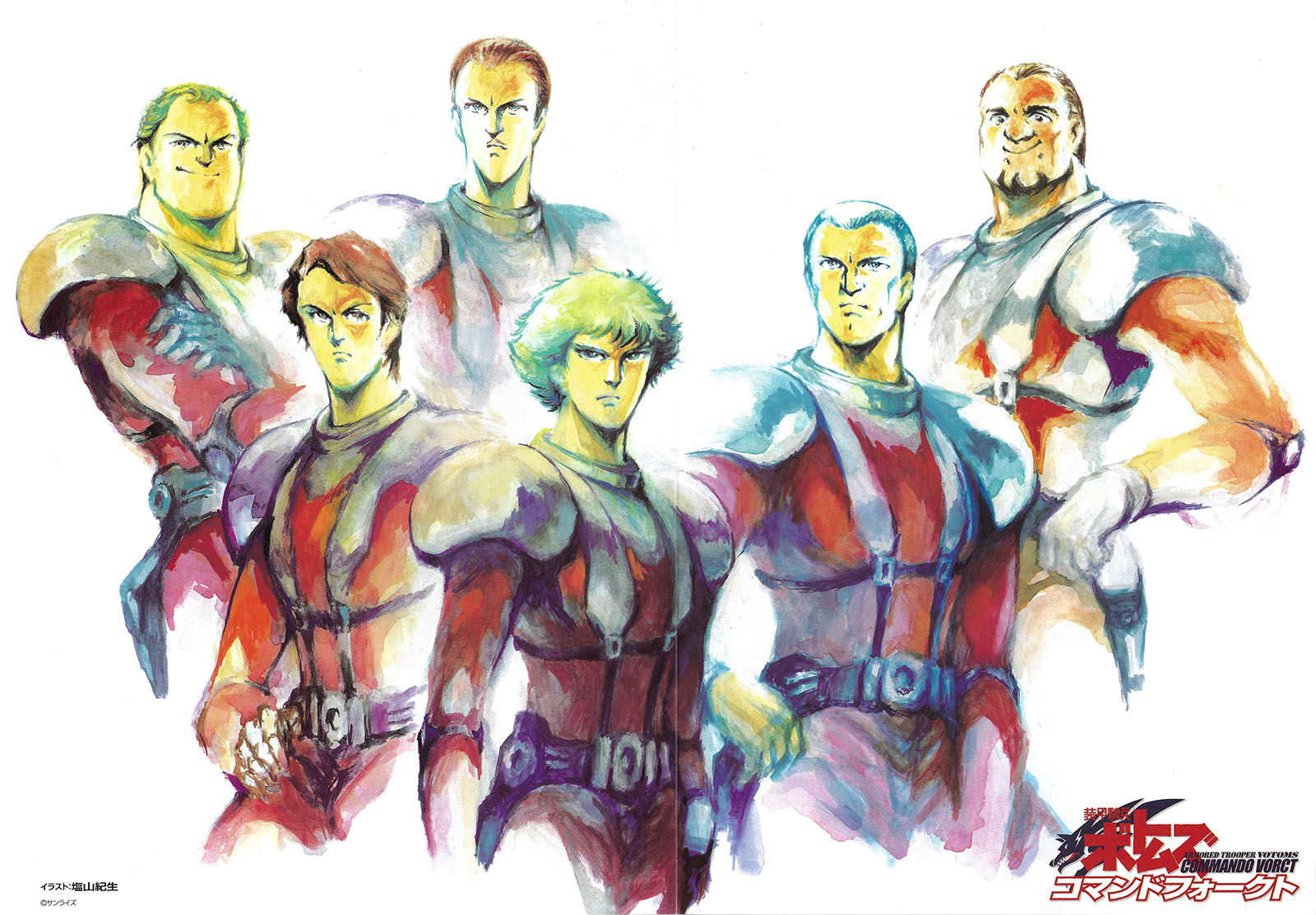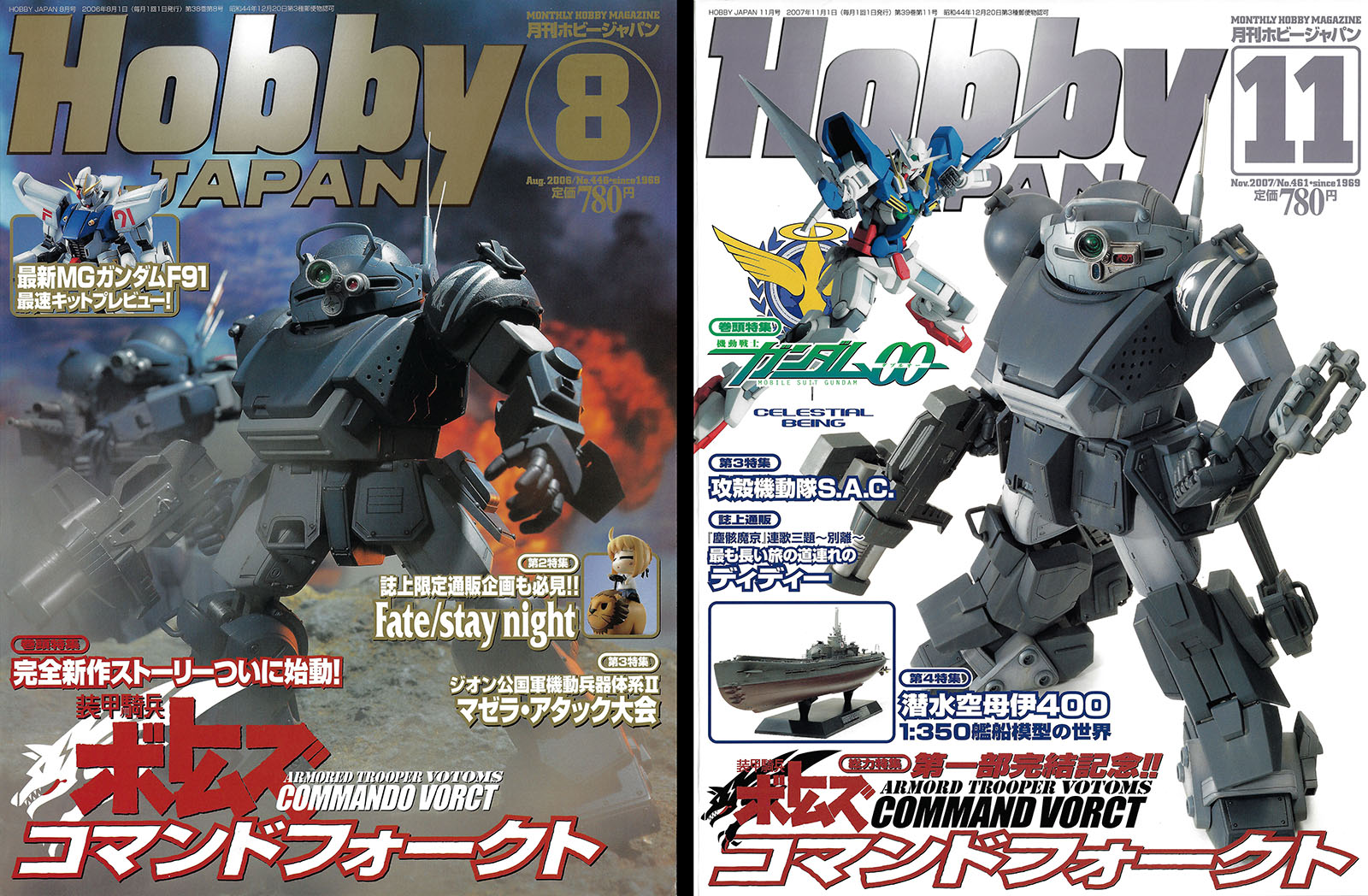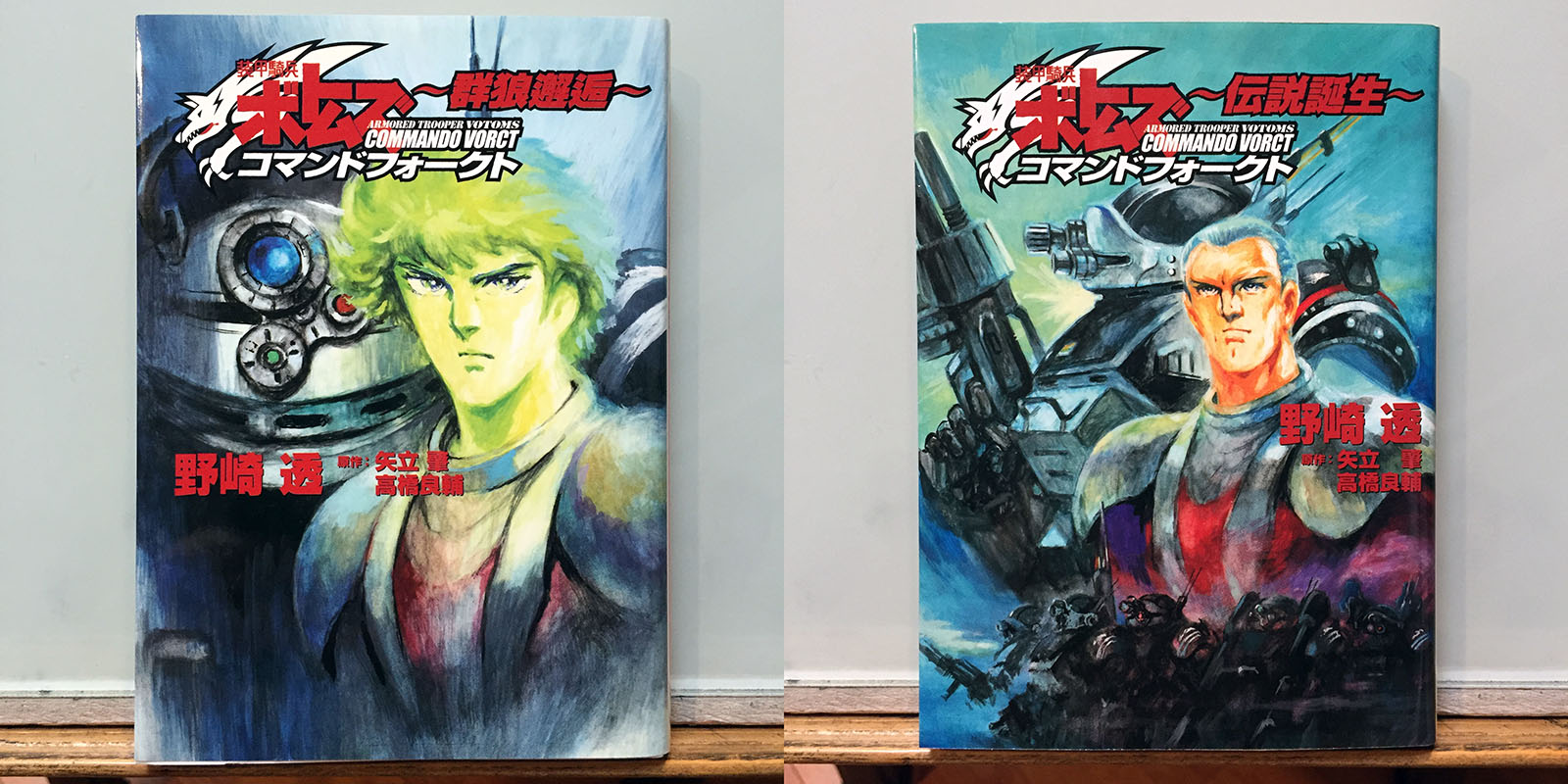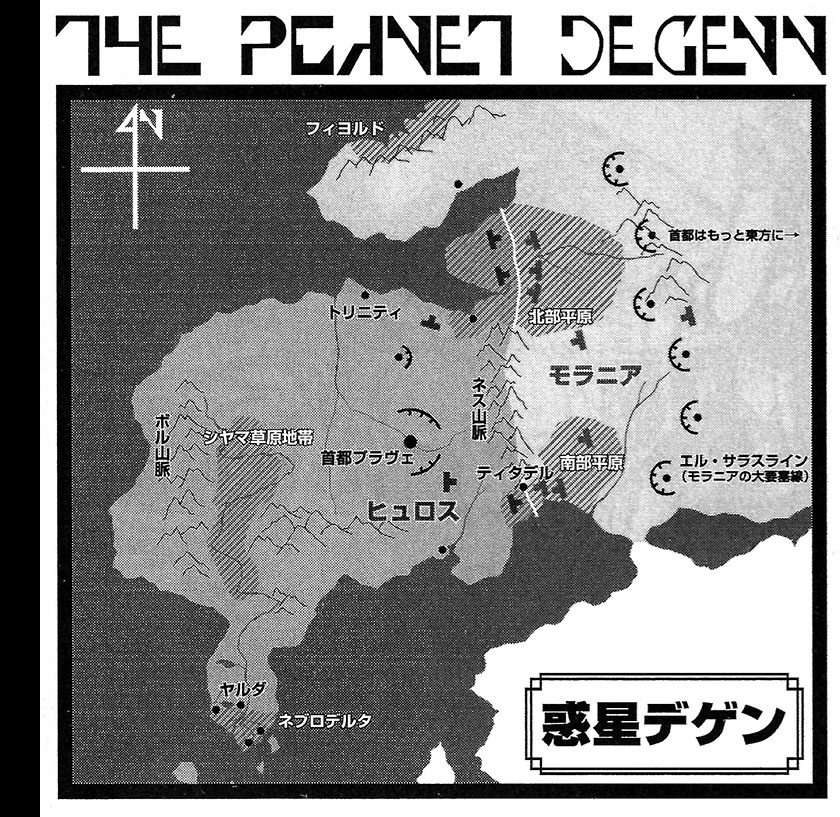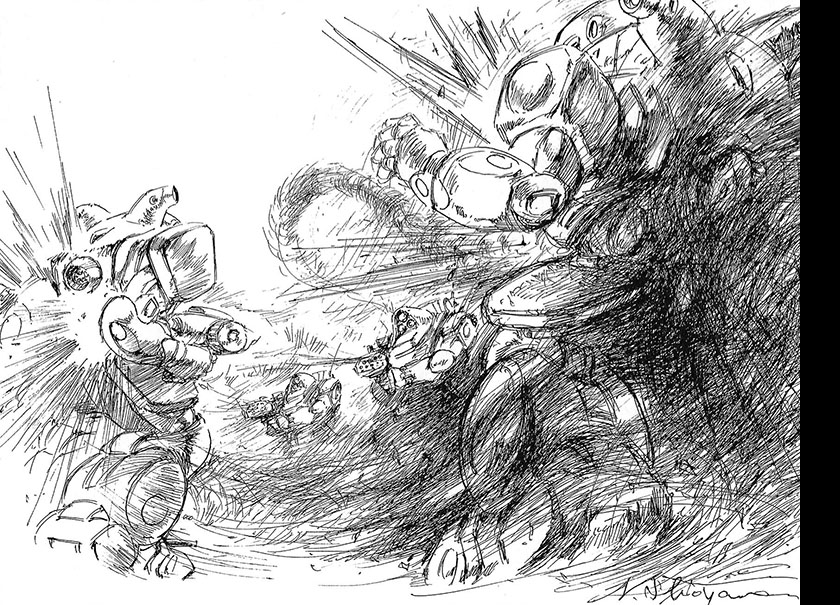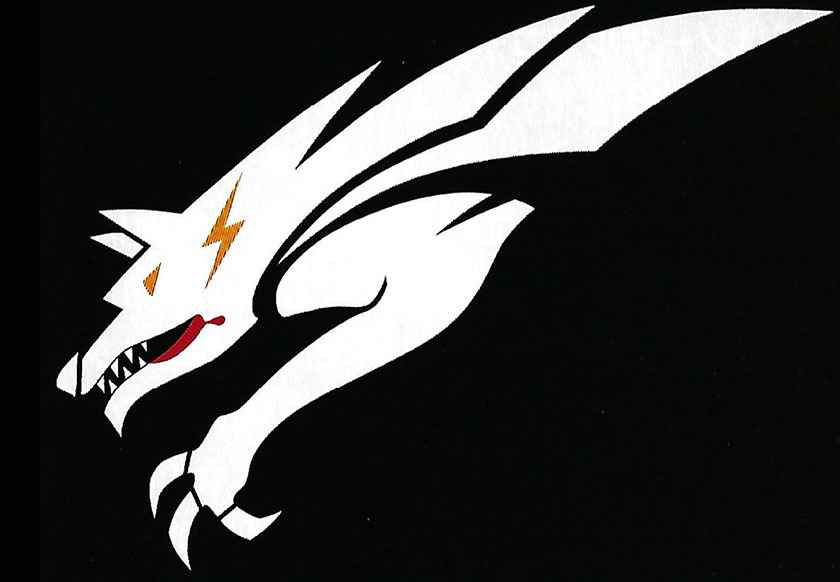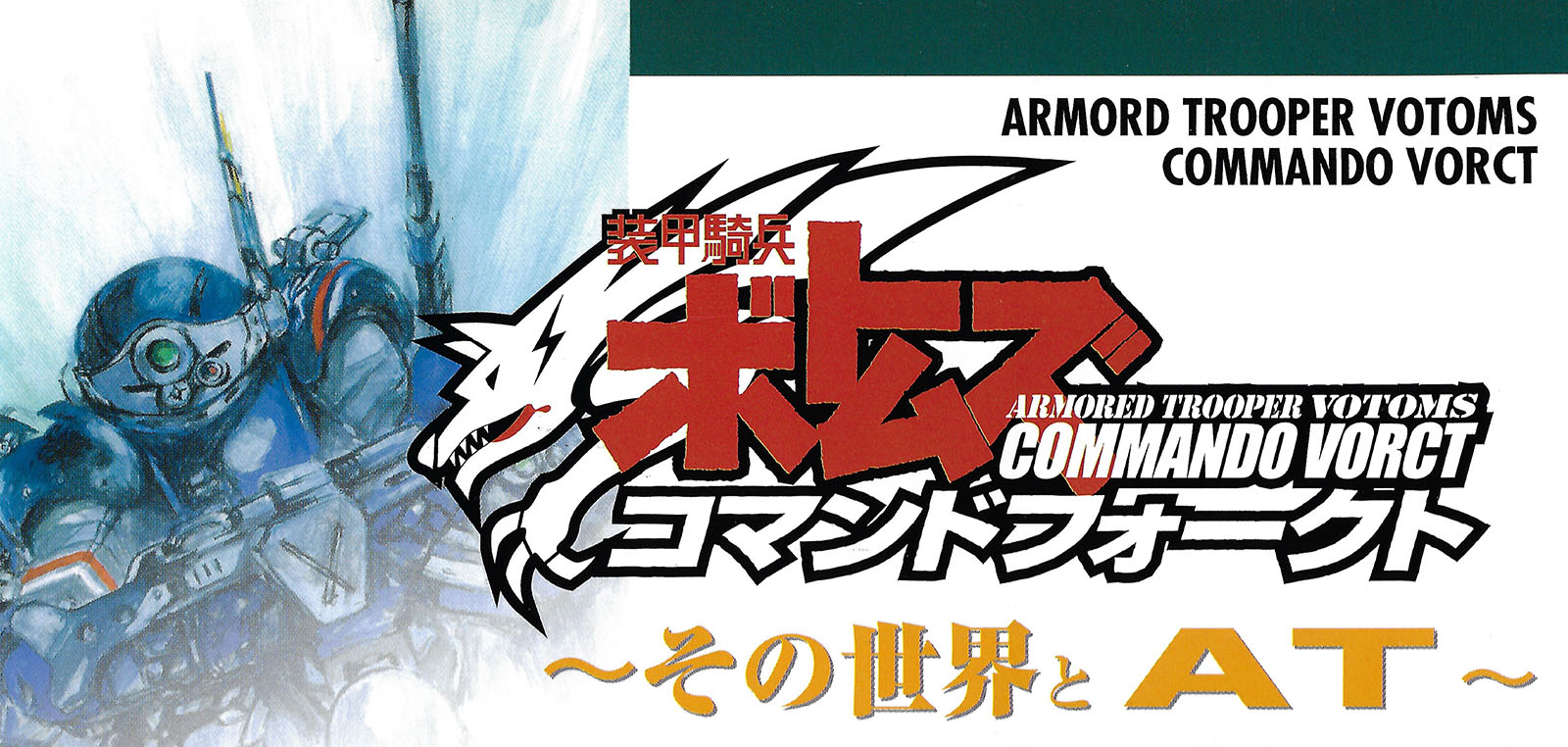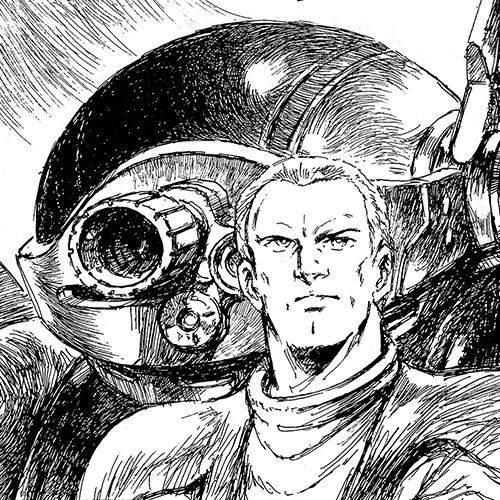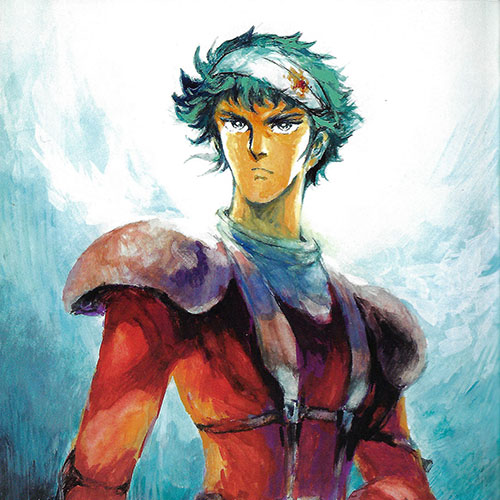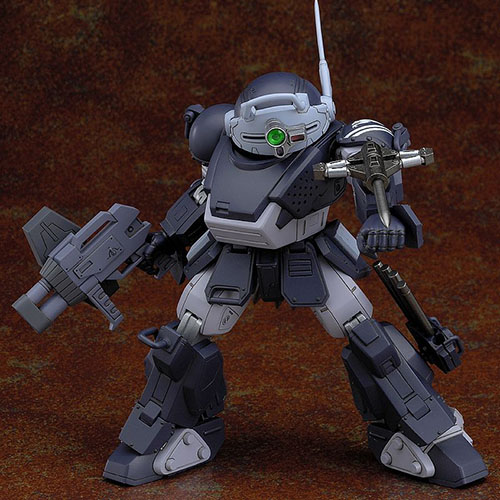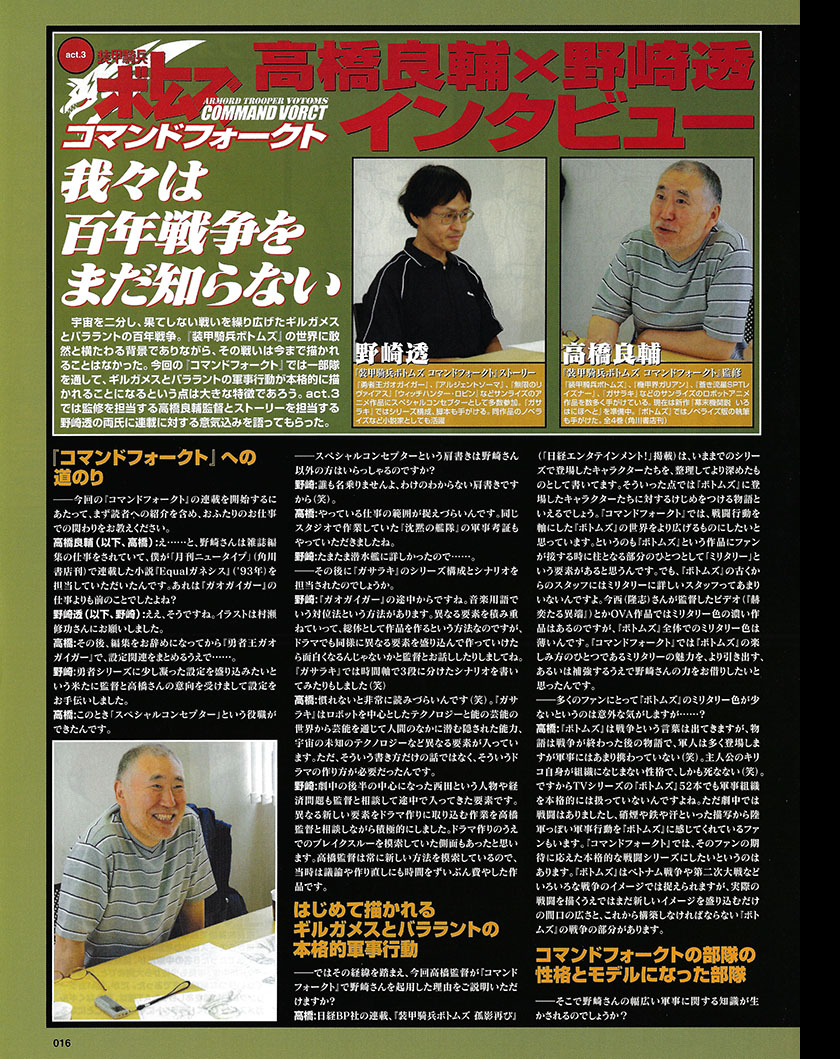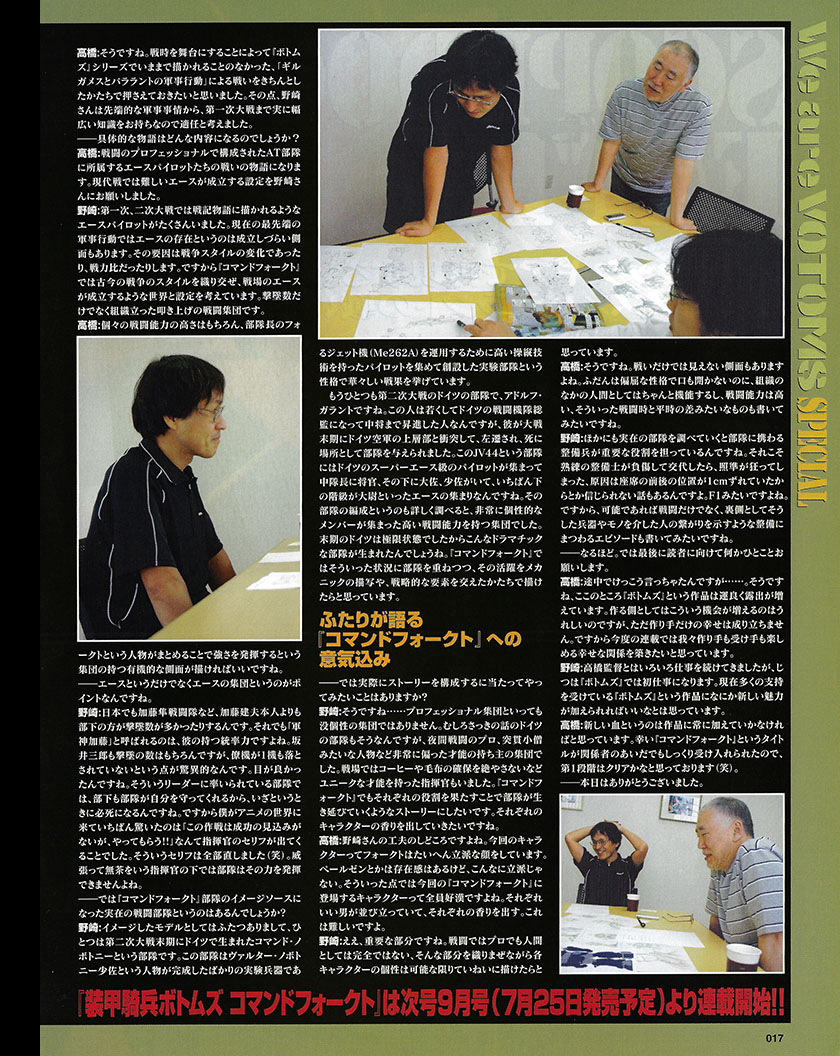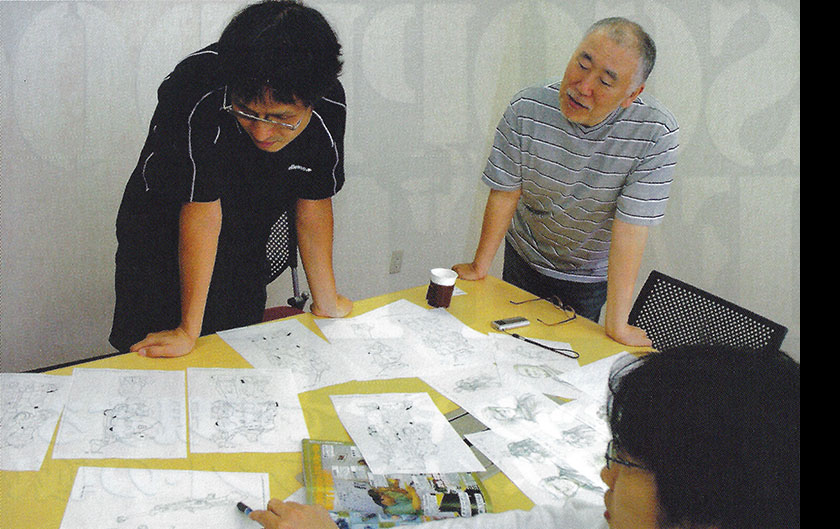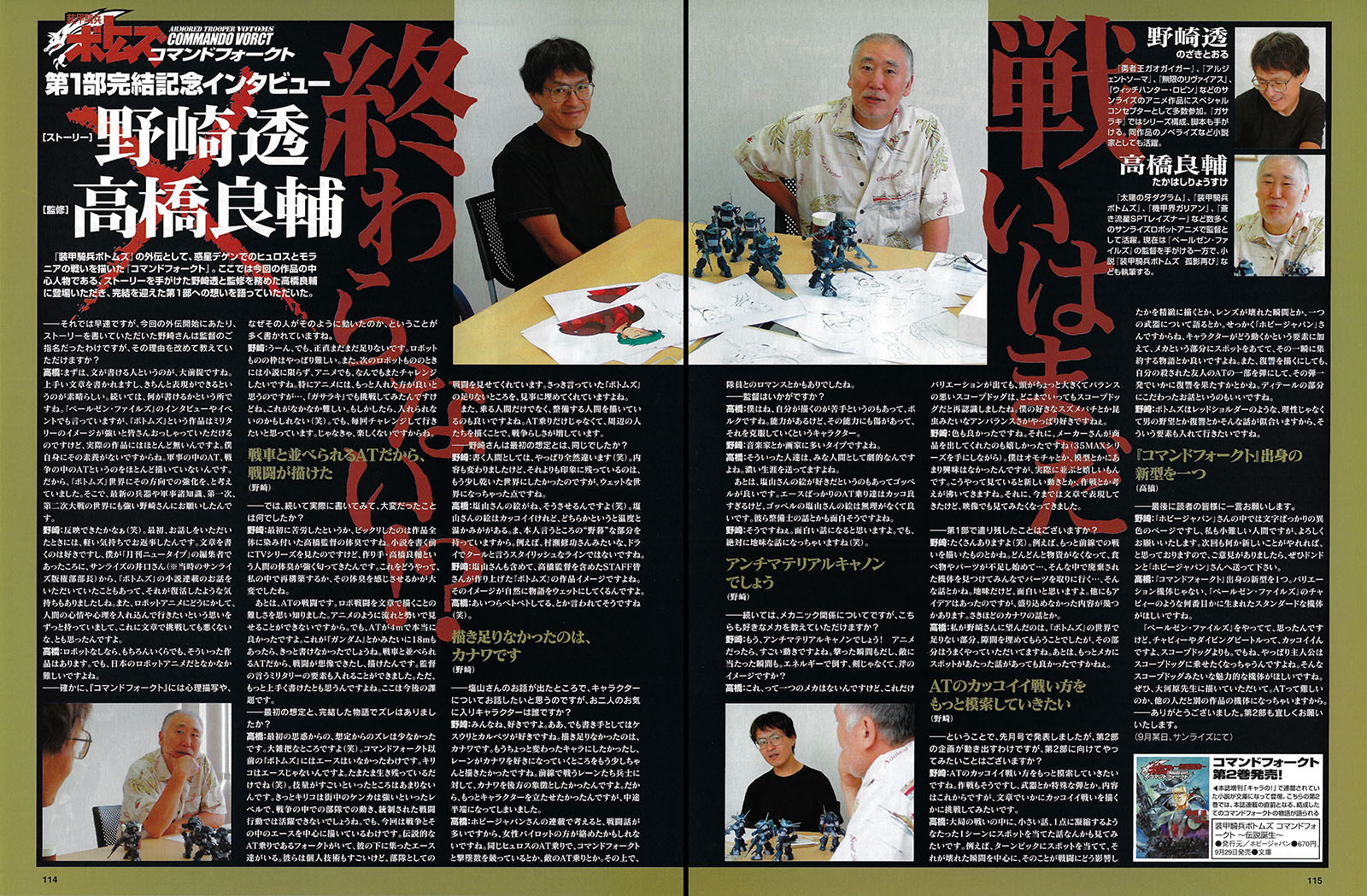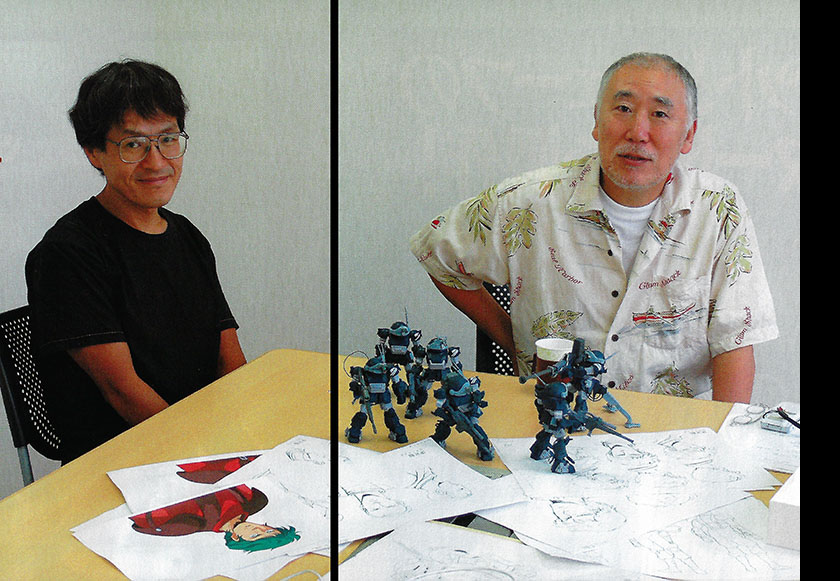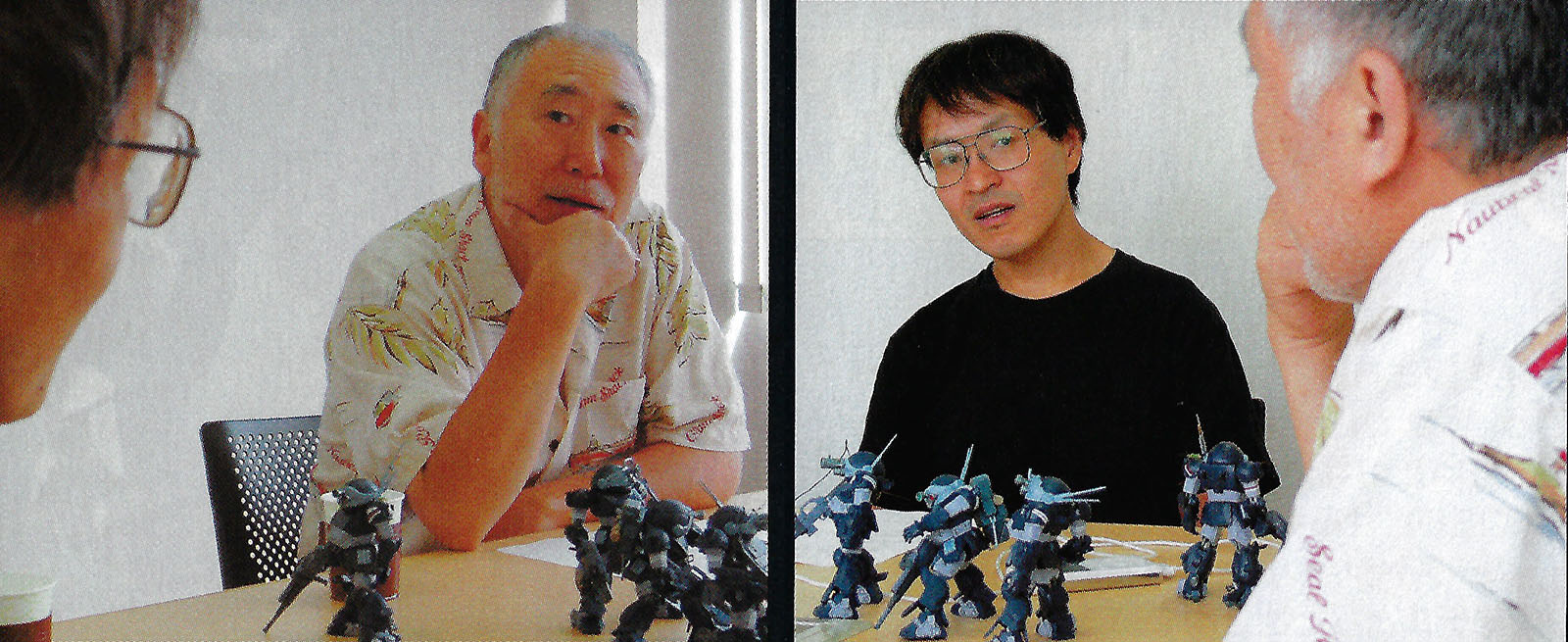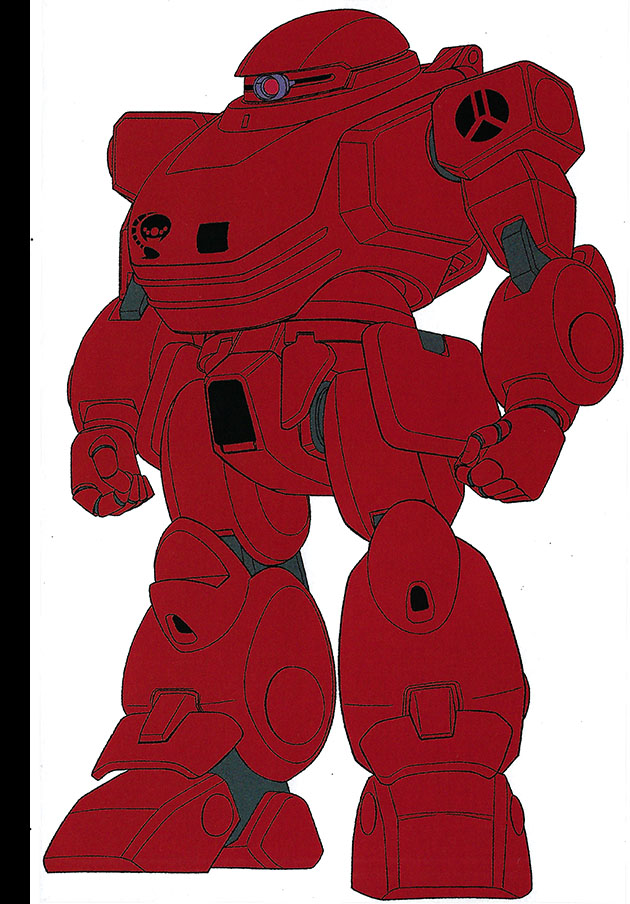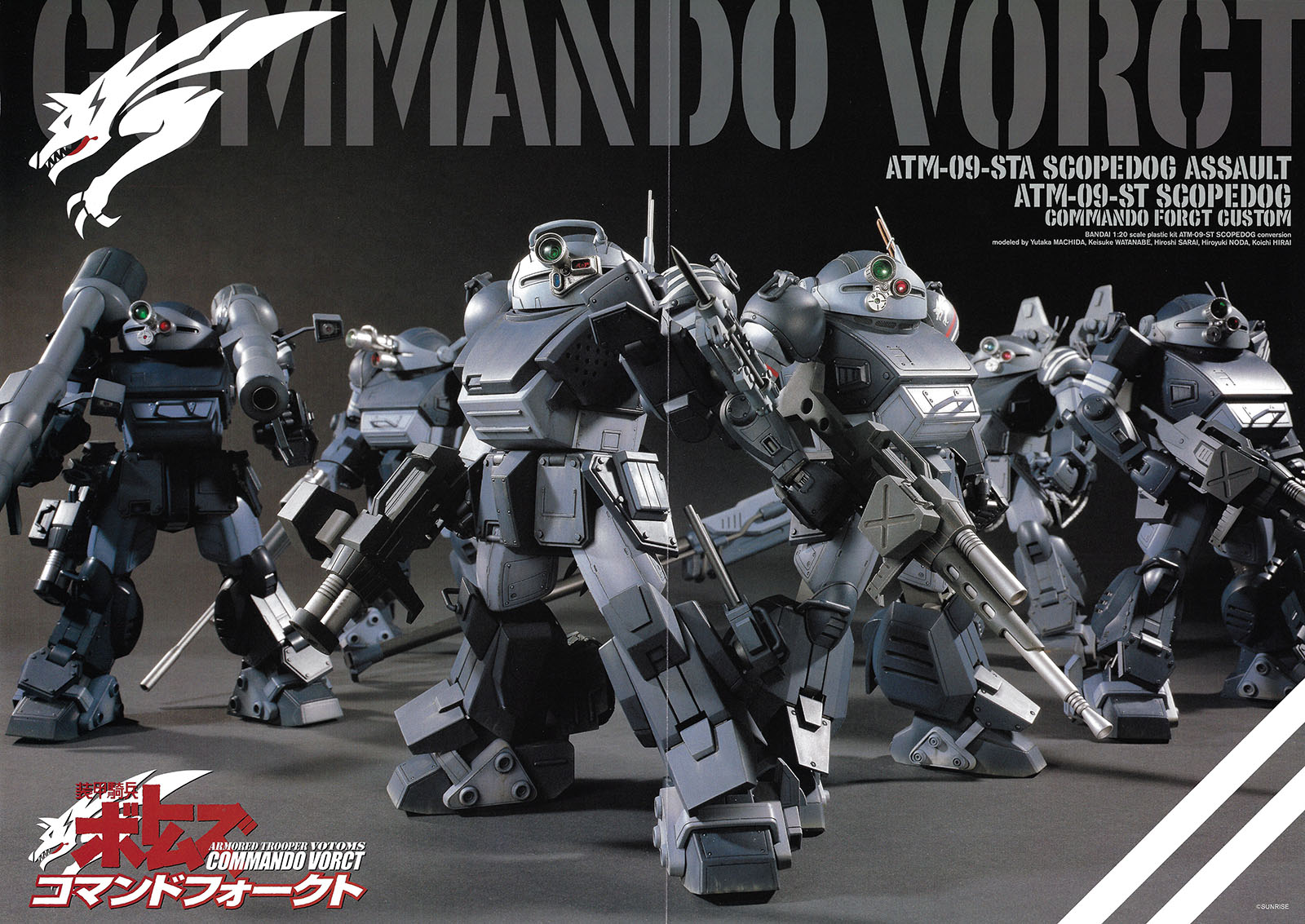Commando Vorct overview
As a mecha anime fan in general and a Votoms fan in particular, there’s something I’ve always had a beef about: Mobile Suit Gundam spinoffs. Don’t get me wrong, I’ve followed and enjoyed many of them. But the Gundam world is inherently limited since it takes place on and around planet Earth. The proof of this limitation is that after a while it had to start branching out into alternate timelines to keep going. And to me, constant reinvention becomes tiresome.
Votoms, on the other hand, has the scope and scale of Star Wars; an entire galaxy to play in with any number of possible stories. Sunrise owns both Gundam and Votoms, but all the anime money goes to Gundam. Fortunately, there are other media besides anime, and that’s where Votoms gets its due.
Commando Vorct is one of the projects that demonstrates the potential, reuniting Director Ryosuke Takahashi, Character Designer Norio Shioyama, and Mecha Designer Kunio Okawara to create a new story. But this time their destination was print media rather than moving pictures. Instead of launching it as an anime, it was born in the pages of Hobby Japan magazine.
The story focuses on a unit of six aces; Armored Trooper pilots in battlefield stories set on a Planet named Degenn. The characters and their ATs were fully designed as if meant for animation, but they became the subject of a serialized novel that ran for 16 consecutive issues of Hobby Japan. The advantage of full-up mecha design was that custom-built models of the ATs could be showcased along with the chapters. As toys and garage kits began to roll out, Hobby Japan covered each of them.
In this unique format, Commando Vorct ran from issue 446 (Aug 2006) to 461 (Nov 2007). But that wasn’t all; a parallel serial could be found in the pages of sister publication Novel Japan, which debuted in October 2006 and ran for nine issues. It was replaced on the stands by a similar magazine titled Chara no! [Of Characters!] and Vorct continued for three more issues before concluding in October 2007.
Hobby Japan was a perfect venue, but the other magazines were strange choices. As you can see from their covers, they didn’t exactly give off an SF/mecha vibe. If you happened across any of those issues in a store you wouldn’t expect to find anything like Votoms in them. Nevertheless, they delivered 13 more chapters with illustrations by Norio Shioyama, which were collected into a pair of paperbacks in 2007.
At the end of the run, it was said in a Hobby Japan interview that all of this represented the “first part” of the project. Since a “second part” has yet to emerge, we can safely assume there won’t be one. Nevertheless, all this effort produced a very interesting body of work that gives us a whole new window into the world of Votoms, and this overview gathers it all in one place.
“But it’s a Japanese novel,” I hear you saying. “We’ll never get to read it.”
Don’t be too sure about that. The Votoms Hub was invented to address exactly that sort of dilemma. All I will say for now is…stay tuned.
The World of Commando Vorct
The Proxy War of Gilgameth and Balarant
Commando Vorct is set on the planet Degenn in a remote region of the Astragius Galaxy. The planet is home to two nations, Hjulos and Morania. The religion called “Marteal” is widely believed. Marteal has many followers not only on Degenn but also across Gilgameth and Balarant. It is a religion with a history of more than 6,000 years. (It was founded in Astragius year 1000, and the Hundred Years War ended in 7213.) Its influence on both Gilgameth and Balarant is very strong. The planet Diagono, where the sacred site Aregium is located, is in neutral space and is not part of the territory of either Gilgameth or Balarant.
HJULOS
At the beginning of the war, Hjulos adopted a policy of neutrality. Later, it joined the Gilgameth side in order to protect its own interests. Although not a large nation, Hjulos has occupied an important position in interplanetary trade, backed by its advanced, technology-intensive industrial base. This has ironically led to the country being inevitably swallowed up by the huge war situation.
Its National Defense Force, nurtured under the idea of self-protection since the neutral era, put up a tremendous fight against Balarant’s offensive at first, but the difference in national strength has become too great to overcome.
MORANIA
Morania possesses a variety of rare resources, including the energy-conversion ore “aeon,” which lies beneath the thick ice of the polar regions. The enormous profits derived from these resources have made this country a militaristic police state for many years.
However, while it outstrips Hjulos in terms of national power, Morania did not pursue a policy of expansion at the beginning of the war because it was well aware of the capabilities of Hjulos’ highly-trained forces. It was Morania’s participation on the Balarant side that brought about a scientific change in its policy. With an ample supply of weapons, Morania’s desire to dominate Hjulos became more overt.
THE HJULOS-MORANIA WAR
This conflict began as a proxy war between the Gilgameth and Balarant sides. At first, it appeared to be a one-sided victory for Morania due to its overwhelmingly superior military strength. However, the Moranian army unexpectedly struggled against the highly trained Hjulos forces, and the battle lines were at a standstill in many places.
In response to this small nation’s struggle, and fearing repercussions in battles taking place on other frontier planets, Balarant stepped up its support for Morania. This prompted a major offensive. Backed by overwhelming numbers, Morania renewed its invasion, and Hjulos was being steadily pushed back toward its capitol.
Commando Vorct
Hjulos Special Forces unit of super aces
Commando Vorct is an elite unit founded by Lieutenant Colonel Andreas Vorct, an AT pilot and national hero of Hjulos. The unit is made up of ace pilots from across the Hjulos army. Although there are only six, including Lt. Col. Vorct, the lowest ranking member is a captain, making it a unique unit. Each member is a professional in their field of expertise with an enemy kill rate of well over 100. With only six men, they have reversed battles at overwhelmingly disadvantaged fronts one after another. Their name became famous throughout the Gilgameth side.
The emblem of Commando Vorct is derived from the common Astradic word for wolf, “Vocrt.” Note, however, that wolves in the Astragius galaxy are different from the wolves we know. It is certain that it is a ground-dwelling carnivore, but the rest is unknown. Maybe it has ten legs, maybe it has three eyes…
Series Background
From AT Complete Report
(Published by Futabasha, June 2007)
Original staff
Commando Vorct was made with the full cooperation of the original Votoms staff, and Sunrise was heavily involved in its production. The participating staff was Ryosuke Takahashi (supervisor), Kunio Okawara (mecha design), and Norio Shioyama (character design). The story is by Tohru Nozaki.
In this series, you can enjoy the fighting style of the worst bastards on another planet in the Astragius Galaxy. Of course, the ATs are based on the Scopedog, but since the main characters are all pros among pros, their machines are customized in various ways. Kunio Okawara’s work gives us a glimpse of potential ATs, which are different from those of previous OVAs.
The construction of ATs in the image of a fighter plane!?
The worldview of Commando Vorct is also very interesting. When someone familiar with military history reads it, they may be struck by a sense of déjà vu. This is because the Commando Vorct ace unit is based on the motif of two units of the German Air Force near the end of World War II. The first was Kommando Nowotny, founded by Major Walter Nowotny, a unit that flew the world’s first jet fighter, the Messerschmitt Me262. The second unit was JV44 founded by Lieutenant General Adolf Galland. The commanders were top aces in the German Air Force, and their units became legendary in the overwhelmingly unfavorable conditions at the end of the war.
Galland in particular, despite his position as a fighter commander and a Lieutenant General, always emphasized the importance of field-orientation and often clashed with his superiors. Near the end of the war, he was essentially demoted to create Jagdverband44 (JV44). He was given free rein to gather the most famous ace fighters, and in just two months, the squadron achieved a total of 104 enemy kills. Most of the personnel were recipients of the Knight’s Iron Cross, so it was also called the Knight’s Iron Cross Fighter Corps.
The setting on Planet Degenn is reminiscent of the Finland front during World War II. The Soviet Union invaded Finland, which fought back despite overwhelming odds (The Winter War and the Continuation War). The success of the Finnish Air Force is also well known. In other words, though the conventional framework of Votoms is ground battle as in the Vietnam War, Commando Vorct feels more like a World War II air battle. Does this concept open up new possibilities for ATs and Votoms? You can judge for yourself by experiencing Commando Vorct.
Hobby Japan articles
Over 16 consecutive issues, Hobby Japan produced a whopping 211 pages of Vorct content. Usually, such an extensive project would later be collected into a dedicated book, but it didn’t happen this time. In lieu of that, every single page can be seen in these galleries:
Issues 446-449 | Issues 450-453 | Issues 454-457 | Issues 458-461
Commando Vorct: the Interviews
In the first and last issues of Vorct’s run in Hobby Japan, readers were treated to interviews with Supervisor Ryosuke Takahashi and Writer Tohru Nozaki. Together, they form interesting bookends that look both forward and back at this interesting project.
INTERVIEW #1 (Hobby Japan #446, August 2006)
We still don’t know the Hundred Years War
The Hundred Years War between Gilgameth and Balarant was a never-ending battle that divided the Astragius Galaxy in two. Although it is a backdrop for the world of Armored Trooper Votoms, the war itself has never been depicted until now. In Commando Vorct, we see the battle between Gilgameth and Balarant through the eyes of one unit.
The military action of Gilgameth and Balarant will be depicted in earnest in Commando Vorct. We asked Ryosuke Takahashi, the director in charge of supervision, and Tohru Nozaki, who is in charge of storytelling, to share their enthusiasm for the project.
Tohru Nozaki, writer
A writer on King of Braves Gaogaigar, Argento Soma, Infinite Ryvius, Witch Hunter Robin, and many more. He has participated in many Sunrise anime productions as a special conceptor. He also worked on the series composition and screenplay of Gasaraki. He is active as a novelist, including the novelization of this work.
Ryosuke Takahashi, supervisor
He has created many robot anime works for Sunrise such as Votoms, Galient, Layzner, Gasaraki, etc. He also wrote the 4-volume novelization of Votoms (published by Kadokawa Shoten). He is currently directing Pailsen Files.
The Road to Commando Vorct
Interviewer: What are your thoughts on starting the serialization of Commando Vorct? First of all, please tell us about your working relationship as an introduction to our readers.
Takahashi: Well, Mr. Nozaki works as a magazine editor, and he was in charge of my novel Equal Ganeshis (1993), which was serialized in NewType (Kadokawa Shoten). That was before your work on Gaogaigar, wasn’t it?
Nozaki: Yes, that’s right. I asked Shuko Murase to do the illustrations.
Takahashi: Then, after you quit your job as an editor, you worked on King of Braves Gaogaigar to put together the concept.
Nozaki: Director Yonetani and Mr. Takahashi wanted to include more elaborate concepts in the Brave series, so I helped with that.
Takahashi: At that time, the position of “special conceptor” was created.
Interviewer: Is there anyone else with the title of “special conceptor” other than you, Mr. Nozaki?
Nozaki: No one else will call themselves that. It’s a title that I don’t understand. (Laughs)
Takahashi: It’s hard to grasp the scope of what we do. You also did the military research for Silent Service, which we were working on at the same studio.
Nozaki: I happened to be familiar with submarines…
Interviewer: Did you take charge of the series composition and script for Gasaraki after that?
Nozaki: I started in the middle of Gaogaigar. There is a method in music called counterpoint in which different elements are piled up to create a work as a whole. I talked with the director about how it would be interesting if we could incorporate different elements into one drama. For Gasaraki, I tried to write a script divided into three stages on a time axis. (Laughs)
Takahashi: It’s very difficult to read if you’re not used to it. (Laughs) Gasaraki has different elements, such as robot-centered technology, abilities hidden in humans through the world of Noh performing arts, and unknown technology in the universe. But it’s not just about that kind of writing. I needed a way to create that kind of drama.
Nozaki: The character of Nishida, who became the center in the second half of the story, and the issue of economics, were elements that came in during discussions with the director. I actively worked with Mr. Takahashi to incorporate new and different elements into the drama. I think we were also looking for breakthroughs in storytelling. Director Takahashi is always looking for new ways of doing things. We spent a lot of time discussing and reworking it.
Gilgameth and Balarant’s full-scale military action is being revealed for the first time
Interviewer: Given that background, can you explain why you chose Mr. Nozaki for Commando Vorct?
Takahashi: In the novella series Armored Trooper Votoms: Alone Again (posted online at Nikkei Entertainment!), I’ve been writing stories that attempt to organize and deepen the characters that appeared in the past series. In that sense, it brings closure to the characters that appeared in Votoms.
In Commando Vorct, which is centered on combat actions, I want to expand the world. I think that one of the pillars of Votoms is the military element that fans come into contact with. However, there aren’t many staff members who are familiar with military matters.
There are some OVA works that have a strong military color, such as Shining Heresy, but the overall military color of Votoms is not very strong. In Commando Vorct, I wanted to borrow Mr. Nozaki’s power to bring out and reinforce the military appeal, which is one of the ways to enjoy Votoms.
Interviewer: It seems surprising to many fans that Votoms doesn’t have a military feel to it.
Takahashi: The word “war” does appear, but the story is set after the war is over. Lots of soldiers appear, but they aren’t really involved in the military. (Laughs) The main character, Chirico himself, doesn’t fit into the organization and he doesn’t die. (Laughs) So even in the TV series, you don’t really deal with military organizations.
But there is fighting, and some fans feel that Votoms has a military action from the depiction of gunpowder, smoke, iron, and sweat. I want to make Commando Vorct a full-fledged combat series that meets the expectations of these fans. Votoms can be seen as an image of the Vietnam War, World War II, and many other wars, but it’s still broad enough to include new images when depicting battles. That’s the “war” part of Votoms that we have to build.
The character of Commando Vorct‘s troops and the real troops that became their model
Interviewer: Will Mr. Nozaki’s extensive knowledge of the military be utilized in this project?
Takahashi: Yes, that’s right. By giving the story a wartime setting, I was able to bring in the military actions of Gilgameth and Balarant, which had never been depicted in a proper form. I thought Mr. Nozaki was the right person for the job because of his wide range of knowledge from cutting-edge military affairs to the First World War.
Interviewer: What exactly will the story be about?
Takahashi: It’s a story of ace pilots who belong to an AT unit composed of combat professionals. I asked Mr. Nozaki to create a setting in which an ace is possible, which is difficult to achieve in modern warfare.
Nozaki: In World War I and II, there were many ace pilots like those depicted in war stories. In current state-of-the-art military operations, it’s difficult to establish the existence of ace pilots. This is due to changes in the style of warfare and the ratio of forces.
Therefore, in Commando Vorct, we’ve tried to mix styles of warfare from the past and the present, to make it possible to become a battlefield ace. It’s not just about the number of shots fired, but also about the organization of the battle group.
Takahashi: Not to mention the high level of individual combat ability. It will be nice if we can depict the organic aspect, in which the strength of the group is demonstrated by the unit leader, Vorct, who brings it all together.
Interviewer: So the point of this project is not only that there’s an “ace” but also there’s a group of “aces”?
Nozaki: In Japan, the Kato Hayabusa Fighter Squadron contained subordinates who shot down more planes than Takeru Kato himself. Even so, the reason he is called “Kato the God of War” is because of his leadership ability.
Saburo Sakai, of course, had more kills than his subordinates. The fact that none of his wingmen were dropped is astounding. He had a good eye, didn’t he? In a unit led by such a leader, the subordinates wouldn’t panic in an emergency, because the unit will protect them.
The most surprising thing to me when I came to the world of anime was to see a commander saying, “This operation has no chance of success, but you’ll do it!” I fixed all such lines. (Laughs) Under a commander who is arrogant and reckless, the troops will not be able to show their strength.
Interviewer: Were any actual combat units the image source for the Commando Vorct unit?
Nozaki: There are two models. One is Kommando Nowotny, which was born in Germany at the end of World War II. This unit was founded by Major Walter Nowotny, who gathered highly skilled pilots to operate an experimental jet plane (Me262A) that had just been completed, and achieved spectacular results.
Another German unit in WWII was led by Adolf Galland. He was a young man who was promoted to the rank of Lieutenant General and became the commissioner of a German fighter squadron. He clashed with the upper echelons of the German Luftwaffe at the end of the war. He was demoted and given a unit as a place to die.
In this unit, called JV44, German super ace pilots were gathered together. The company commander was a general, and under him were a colonel and a major. The lowest rank was captain. If you look into the organization of the unit in detail, you will find that it was a group of very individualistic members with high combat capability. The German army at the end of the war was in an extreme situation, which must have led to the creation of such a dramatic unit.
In Commando Vorct, I’d like to present it in a form that incorporates strategic elements while building a unit like that with descriptions of mecha.
The pair’s enthusiasm for Commando Vorct
Interviewer: Is there anything you would like to try when actually composing the story?
Nozaki: Well…it’s a group of professionals, but they do not lack individuality. It’s more like the German unit I was talking about earlier, with eclectic talents like a night combat pro or a kid who always rushes in. There were also commanders with unique talents, such as always keeping coffee or blankets available on the battlefield. I want the story to be one where the troops survive by fulfilling their respective roles. I want to bring out the flavor of each character.
Takahashi: That’s the key to your ingenuity, isn’t it? Vorct is a very handsome character in this project. Pailsen has a presence, but he is not this magnificent. In that sense, all the characters in Commando Vorct are good-looking men. Each of them is a good man, and each of them has his own flavor. This is a difficult task.
Nozaki: Yes, that’s the important part. Even though if you’re a pro in battle, you may not be perfect as a human being. I try to depict each character’s personality as carefully as possible while weaving in such aspects.
Takahashi: That’s right. There are aspects that can’t be seen only in battle. Normally, they’re eccentric and don’t open their mouths, but as people in an organization, they function properly and are highly capable in battle. They have high combat ability, but I’d like to write about the difference between battle and peacetime.
Nozaki: When I researched actual units, I found that mechanics play an important role. I found that when a skilled mechanic was injured and replaced, the aiming sights were off, for example. There are unbelievable stories, like the position of a seat being off by just 1 centimeter. It’s like Formula One, isn’t it?
So I would like to write not only about battles, but also about maintenance moments that show the connection between people behind the scenes through weapons and objects.
Interviewer: I see. Finally, do you have anything to say to our readers?
Takahashi: Votoms has been fortunate to get a lot of exposure recently. As a creator, I’m happy to have more opportunities like this. However, it’s not enough for only the creators to be happy. Therefore, in this series I’d like to build a happy relationship that both the creator and the recipient can enjoy.
Nozaki: I’ve worked with Director Takahashi for many years, but this will be my first time working on Votoms. I hope to add something new to Votoms, which is currently receiving a lot of support.
Takahashi: New blood is something I always try to add to my work. Fortunately, the title Commando Vorct was well-received by the people involved. I think we’ve cleared the first stage. (Laughs)
Interviewer: Thank you very much for your time today.
INTERVIEW #2 (Hobby Japan #461, November 2007)
Commemorating the completion of the first part
As a side story to Armored Trooper Votoms, Commando Vorct depicts the battle between Hjulos and Morania on the planet Degenn. Here, we introduce Tohru Nozaki, who wrote the story, and Ryosuke Takahashi, who supervised the production. They shared their thoughts on the first part, which is now complete.
Interviewer: To start with, Mr. Nozaki, who wrote the story, was the director’s first choice. Could you tell us again why?
Takahashi: First of all, he’s a good writer, and it’s wonderful that he can express himself properly. Next is what he can write. I have said in interviews and events for Pailsen Files that Votoms has a strong military image, but in reality there is very little of that. I don’t have that kind of background myself. I haven’t depicted military ATs or ATs in war for the most part. That’s why I wanted to strengthen the world of Votoms in that direction. I wanted to bring in the latest weaponry and military knowledge. I asked Mr. Nozaki, who is very knowledgeable about WWI and WWII, to help me.
Nozaki: I wonder if I was able to reflect that. (Laughs) I responded to your offer with a light heart. I like writing, and when I was an editor of NewType, Mr. Iguchi of Sunrise (Director of Sunrise’s copyright department at that time) asked me to write a serialized novel for Votoms. It felt like it was being revived. I’ve always wanted to somehow incorporate human emotions and psychology into robot anime. I thought it wouldn’t be a bad idea to try my hand at this.
Takahashi: Of course, there are plenty of works without robots. But with Japanese robot anime, it’s quite difficult.
Interviewer: It’s true that Commando Vorct contains a lot of psychological descriptions and reasons why a person goes a certain way.
Nozaki: But to be honest, it’s still not enough. It’s still difficult to make a framework for a robot story. I would like to try my hand at robot stories again. Not only novels, but also animated films, or anything else. I think I should put more effort into anime in particular. I tried with Gasaraki, but it was very difficult. Maybe I can’t get in. (Laughs) But I want to challenge myself every time. Otherwise, it won’t be fun.
I could depict a battle because ATs can be stood up next to a tank
(Nozaki)
Interviewer: What was the hardest part of actually writing it?
Nozaki: What surprised me and gave me the hardest time was the sensibility of director Takahashi that permeated the entire work. I could feel it when I watched the TV series before writing the story. It was very difficult for me to reconstruct that and make the audience feel it.
Then there’s the AT combat. I realized how difficult it is to depict robot combat in writing. I couldn’t show it with the same flow and momentum as in anime. However, I was really happy that the AT was only 4 meters tall. If it had been 18 meters, like in Gundam, I wouldn’t have been able to write it.
Because the AT could be stood up next to a tank, I could imagine and depict the battle. I was also able to include the military elements that the director mentioned. However, I think I could have written it better. This is something I’ll work on in the future.
Interviewer: Was there any gap between your initial idea and the completed story?
Takahashi: There weren’t many deviations from the initial idea and assumptions. It’s a very rough place. (Laughs) There was no ace in Votoms before Commando Vorct. Chirico is not an ace, he just happens to be alive. (Laughs) There is no great skill there. He’s strong in street fights, but probably not in controlled combat actions, such as troop movements in a war.
But this time, the focus is on the war and the aces fighting it. There is Vorct, a legendary AT pilot, and the aces who gathered under him. They have amazing individual skills, but they also fight as a unit. They do a great job of filling in the missing pieces of Votoms that I mentioned earlier. Also, it’s good to portray not only the pilots, but also the people who support them. It adds to the war-like atmosphere.
Interviewer: Mr. Nozaki, was it the same as what you had in mind at the beginning?
Nozaki: As a writer, to me it’s totally different. (Laughs) The content has changed, but what I was more impressed with was that the dry world I envisioned turned out to be a bit “wetter.”
Takahashi: It’s Mr. Shioyama’s drawings that make it that way. (Laughs) They’re cool, but they have also a certain temperature and warmth. He has what he calls a “sketchy” side to his art. It’s not a dry, cool, stylish line like, for example, Shuko Murase’s work.
Nozaki: The image of Votoms was created by all the staff members including Mr. Takahashi, the director. That image naturally makes the story “wet.”
Takahashi: I think most people would say “sticky.” (Laughs)
What I didn’t depict enough was Kanawa!
(Nozaki)
Interviewer: Now that you mentioned Mr. Shioyama, I’d like to talk about characters. Who’s your favorite?
Nozaki: I like them all. But as a writer, I like Cesuri and Karpets. The one I didn’t show enough of is Kanawa. I wanted to make the character a little different, and I wanted to more clearly show Rane’s growing love for her. I wanted Kanawa to be a symbol of the rear while Rane and the other soldiers fight on the front. So I wanted her to stand out more, but it ended up going only halfway.
Takahashi: When I think about Hobby Japan‘s serialization, there are a lot of combat stories, so I thought a female pilot could have been involved. Maybe an AT pilot in the same Hjulos squadron, competing with Commando Vorct for the number of kills, or an AT pilot of the enemy squadron. On top of that, there could have been a romance with a squadron member.
Interviewer: Who was your favorite, Mr. Takahashi?
Takahashi: I chose Borque. He has abilities, but those abilities come with flaws, and he overcomes those flaws.
Nozaki: Musicians and painters often have this type of character.
Takahashi: They are all dramatic as human beings. They’ve lived intense lives. I also like Koppel because I like Mr. Shioyama’s drawings. His drawings of Koppel are good without being forced. The stories of the mechanics are also interesting.
Nozaki: Yes, I think so. I think it would be an interesting story. But it would definitely be a very simple one. (Laughs)
The anti-materiel cannon
(Nozaki)
Interviewer: Next, can you tell us about your favorite mecha?
Nozaki: I would have to say the anti-materiel cannon! If this was anime, it would have amazing movement. The moment he shoots, and the moment he hits the enemy. Isn’t it the image of an axe, rather than a sword, that kills with energy?
Takahashi: There is no single mecha for me, but even with all these variations, the Scopedog’s head is a little too big and unbalanced. I realized again that a Scopedog is still a Scopedog, no matter how far it goes. I really like the unbalance of my favorite insects, like wasps.
Nozaki: The color is also good. I was happy to see that the makers of the products were able to produce a full range of them (holding the 35 Max series in his hand). I’m not really interested in toys or models, but it was nice to see them in a lineup. Seeing them like this, I can’t help but think of new movements and strategies. I’ve been expressing myself in the form of literature, but now I’d like to see it on film as well.
Interviewer: Is there anything you left undone in the first part of the project?
Nozaki: There are many things. (Laughs) For example, I would have liked to have depicted more of the front line battles. Running out of supplies, food, parts…then they find an abandoned aircraft and everyone goes to get the parts. Something like that. It’s a simple story, but I think it’s interesting. I had a few other ideas that I couldn’t include. Like Kanawa’s story mentioned earlier.
Takahashi: What I wanted Mr. Nozaki to do was to fill in the gaps in the Votoms world, and he did that very well. I would have liked to see more of a mecha spotlight in the story.
I would like to explore more cool ways to fight with ATs
(Nozaki)
Interviewer: As we announced in last month’s issue, the second part of the project is about to get underway. What would you like to do for the second part?
Nozaki: I’d like to explore more cool ways to fight with ATs, such as strategies, weapons, special bullets, and so on. I’m still working on the content, but I’d like to try my hand at depicting cool battles in writing.
Takahashi: I’d like to make a small story in the midst of a big battle, a story that focuses on a single scene. For example, I’d like to spotlight a turnpick and focus on the moment when it breaks. Or the moment when a lens is broken, or a story about a single weapon. Since this is Hobby Japan, in addition to the character element, we can also focus on the mecha and tell a story concentrated on that moment.
Also, in depicting revenge, it would be good to take part of an AT that belonged to a friend who was killed and use it as a bullet, and to show how a single bullet can be used to retaliate. It’s nice to have a story that focuses on details.
Nozaki: Votoms isn’t just about Red Shoulders, but about a man’s ambition, revenge, and so on. I’d like to include such elements.
One new model from Commando Vorct
(Takahashi)
Interviewer: Finally, could you give a message to our readers?
Nozaki: This is a unique page in Hobby Japan because it’s all text, and I can be a trying person, but thank you for your support. I hope to do something new next time, so if you have any suggestions, please feel free to send them to Hobby Japan.
Takahashi: I’d like one new model kit from Commando Vorct. Not a variation. I’d like to see a standard model of the Chubby from Pailsen Files. When I was working on that, I was thinking the Chubby and the Diving Beetle are cooler than the Scopedog. But I still want to put the main character in a Scopedog, don’t I?
I’d like to have another machine as attractive as the Scopedog. I’d love to have Mr. Okawara draw it. I don’t know how hard it is to draw ATs, but if it was anyone else, it would look like it came from another work.
Interviewer: Thank you very much. I look forward to working with you again on the second part.
(September 2007, at Sunrise)

